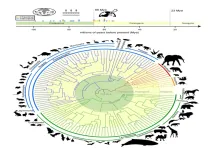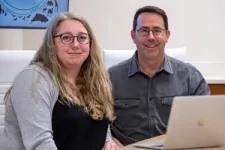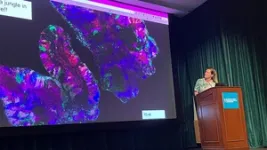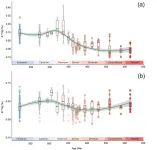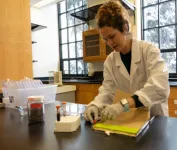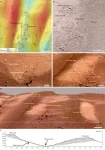(Press-News.org) Research led by a team of scientists from the Texas A&M School of Veterinary Medicine and Biomedical Sciences puts to bed the heated scientific debate regarding the history of mammal diversification as it relates to the extinction of the non-avian dinosaurs. Their work provides a definitive answer to the evolutionary timeline of mammals throughout the last 100 million years.
The study, published in Science, is part of a series of articles released by the Zoonomia Project, a consortium of scientists from around the globe that is using the largest mammalian genomic dataset in history to determine the evolutionary history of the human genome in the context of mammalian evolutionary history. Their ultimate goal is to better identify the genetic basis for traits and diseases in people and other species.
The Texas A&M University research — led by Dr. William J. Murphy, a professor in the Department of Veterinary Integrative Biosciences, and Dr. Nicole Foley, an associate research scientist in Murphy’s lab — is rooted in phylogeny, a branch of biology that deals with the evolutionary relationships and diversification of living and extinct organisms.
“The central argument is about whether placental mammals (mammals that develop within placentas) diverged before or after the Cretaceous-Paleogene (or K-Pg) extinction event that wiped out the non-avian dinosaurs,” Foley shared. “By performing new types of analyses only possible because of Zoonomia’s massive scope, we answer the question of where and when mammals diversified and evolved in relation to the K-Pg mass extinction.”
The research — which was conducted with collaborators at the University of California, Davis; University of California, Riverside; and the American Museum of Natural History — concludes that mammals began diversifying before the K-Pg extinction as the result of continental drifting, which caused the Earth's land masses to drift apart and come back together over millions of years. Another pulse of diversification occurred immediately following the K-Pg extinction of the dinosaurs, when mammals had more room, resources and stability.
This accelerated rate of diversification led to the rich diversity of mammal lineages — such as carnivores, primates and hoofed animals — that share the Earth today.
Murphy and Foley’s research was funded by the National Science Foundation and is one part of the Zoonomia Project led by Elinor Karlsson and Kerstin Lindblad-Toh, of the Broad Institute, which also compares mammal genomes to understand the basis of remarkable phenotypes — the expression of certain genes such as brown vs. blue eyes — and the origins of disease.
Foley pointed out that the diversity among placental mammals is exhibited both in their physical traits and in their extraordinary abilities.
“Mammals today represent enormous evolutionary diversity — from the whizzing flight of the tiny bumblebee bat to the languid glide of the enormous Blue Whale as it swims through Earth’s vast oceans. Multiple species have evolved to echolocate, some produce venom, while others have evolved cancer resistance and viral tolerance,” she said.
“Being able to look at shared differences and similarities across the mammalian species at a genetic level can help us figure out the parts of the genome that are critical to regulate the expression of genes,” she continued. “Tweaking this genomic machinery in different species has led to the diversity of traits that we see across today’s living mammals.”
Murphy shared that Foley’s resolved phylogeny of mammals is crucial to the goals of the Zoonomia Project, which aims to harness the power of comparative genomics as a tool for human medicine and biodiversity conservation.
“The Zoonomia Project is really impactful because it's the first analysis to align 241 diverse mammalian genomes at one time and use that information to better understand the human genome,” he explained. “The major impetus for putting together this big data set was to be able to compare all of these genomes to the human genome and then determine which parts of the human genome have changed over the course of mammalian evolutionary history.”
Determining which parts of genes can be manipulated and which parts cannot be changed without causing harm to the gene’s function is important for human medicine. A recent study in Science Translational Medicine led by one of Murphy and Foley’s colleagues, Texas A&M geneticist Dr. Scott Dindot, used the comparative genomics approach to develop a molecular therapy for Angelman syndrome, a devastating, rare neurogenetic disorder that is triggered by the loss of function of the maternal UBE3A gene in the brain.
Dindot’s team took advantage of the same measures of evolutionary constraint identified by the Zoonomia Project and applied them to identify a crucial but previously unknown genetic target that can be used to rescue the expression of UBE3A in human neurons.
Murphy said expanding the ability to compare mammalian genomes by using the largest dataset in history will help develop more cures and treatments for other species' ailments rooted in genetics, including cats and dogs.
“For example, cats have physiological adaptations rooted in unique mutations that allow them to consume an exclusively high-fat, high-protein diet that is extremely unhealthy for humans,” Murphy explained. “One of the beautiful aspects of Zoonomia’s 241-species alignment is that we can pick any species (not just human) as the reference and determine which parts of that species’ genome are free to change and which ones cannot tolerate change. In the case of cats, for example, we may be able to help identify genetic adaptations in those species that could lead to therapeutic targets for cardiovascular disease in people.”
Murphy and Foley’s phylogeny also played an instrumental role in many of the subsequent papers that are part of the project.
“It’s trickle-down genomics,” Foley explained. “One of the most gratifying things for me in working as part of the wider project was seeing how many different research projects were enhanced by including our phylogeny in their analyses. This includes studies on conservation genomics of endangered species to those that looked at the evolution of different complex human traits.”
Foley said it was both meaningful and rewarding to definitively answer the heavily debated question about the timing of mammal origins and to produce an expanded phylogeny that lays the foundation for the next several generations of researchers.
“Going forward, this massive genome alignment and its historical record of mammalian genome evolution will be the basis of everything that everyone's going to do when they're asking comparative questions in mammals,” she said. “That is pretty cool.”
By Rachel Knight, Texas A&M University School of Veterinary Medicine & Biomedical Sciences
###
END
Texas A&M research redefines mammalian tree of life
The research uses the genomes of 241 species and can be used to support animal and human health outcomes.
2023-04-28
ELSE PRESS RELEASES FROM THIS DATE:
Twelve outstanding journalists named 2023 MBL Logan Science Journalism Fellows
2023-04-28
WOODS HOLE, Mass. –Twelve accomplished science and health journalists have been awarded a highly competitive fellowship in the Logan Science Journalism Program at the Marine Biological Laboratory (MBL).
Now in its 36th year, the Logan Science Journalism Program provides journalists with immersive, hands-on research training, giving them invaluable insight into the practice of science as well as some of the major news stories of today. The program, which offers a Biomedical course and an Environmental course, will run May 30-June 9 in Woods Hole.
Biographies ...
Improved gene editing method could power the next generation of cell and gene therapies
2023-04-28
PHILADELPHIA— A new approach to the genetic engineering of cells promises significant improvements in speed, efficiency, and reduction in cellular toxicity compared to current methods. The approach could also power the development of advanced cell therapies for cancers and other diseases, according to a study from researchers in the Perelman School of Medicine at the University of Pennsylvania.
In the study, which appeared this week in Nature Biotechnology, researchers found that protein fragments used by some viruses to help them get into cells could ...
ATAD3A: A molecular determinant favoring head and neck cancer development
2023-04-28
“[...] developing targeted therapies that specifically inhibit ATAD3A in cancer cells while sparing normal cells will be a challenging but critical task.”
BUFFALO, NY- April 28, 2023 – A new research perspective was published in Oncoscience (Volume 10) on April 4, 2023, entitled, “Mitochondrial regulator ATAD3A: a molecular determinant favoring head and neck cancer development.”
In addition to their role in energy metabolism, mitochondria play important roles in other cellular processes, such as apoptosis, calcium signaling and the synthesis of certain biomolecules. Mitochondria have also been ...
Vascular plants colonized land extensively by the early Silurian: Study
2023-04-28
The colonization and expansion of plants on land represent a defining landmark for the path of life on Earth. Terrestrial colonization has been attributed to a series of major innovations in plant body plans, anatomy, and biochemistry that transformed global biogeochemical cycles and climates.
It is crucial to identify the onset and track the expansion of those earliest land plants. However, the precise timing of land colonization by vascular plants remains controversial due to the sparseness of early land plant megafossils, poor stratigraphic controls ...
Machine learning helps scientists identify the environmental preferences of microbes
2023-04-28
Researchers have figured out a way to predict bacteria’s environmental pH preferences from a quick look at their genomes, using machine learning. Led by experts at the University of Colorado Boulder, the new approach promises to help guide ecological restoration efforts, agriculture, and even the development of health-related probiotics.
“We know that in any environment, there’s a ton of bacteria with important ecological functions, but their environmental preferences often remain unknown,” said Noah Fierer, a fellow of the Cooperative Institute for Research in Environmental ...
Tianwen-1: Zhurong Rover finds evidence of water at low latitudes on modern Mars
2023-04-28
The Zhurong rover has found evidence of water on dune surfaces on modern Mars by providing key observational proof of liquid water at low Martian latitudes, according to a study led by Prof. QIN Xiaoguang from the Institute of Geology and Geophysics (IGG) of the Chinese Academy of Sciences (CAS).
The study was published in Science Advances on April 28.
Researchers from the National Astronomical Observatories of CAS and the Institute of Atmospheric Physics of CAS were also involved in the study.
Previous ...
Looking for insights from our nearest star-forming galaxy
2023-04-28
Vallia Antoniou, an assistant professor of practice in the Department of Physics and Astronomy at Texas Tech, has been awarded observing time on the powerful Chandra X-Ray Telescope to explore some of the deepest recesses of the universe.
It marks the second major Chandra program led by Antoniou, who is also a research associate with the Smithsonian Astrophysical Observatory.
Each year, astronomers from around the world follow a rigorously competitive process to receive Chandra time. The telescope was launched aboard the space shuttle Columbia in 1999 and orbits Earth, offering previously unavailable views of deep space at wavelengths that are not accessible from ground telescopes. During ...
MIT engineers “grow” atomically thin transistors on top of computer chips
2023-04-28
CAMBRIDGE, MA — Emerging AI applications, like chatbots that generate natural human language, demand denser, more powerful computer chips. But semiconductor chips are traditionally made with bulk materials, which are boxy 3D structures, so stacking multiple layers of transistors to create denser integrations is very difficult.
However, semiconductor transistors made from ultrathin 2D materials, each only about three atoms in thickness, could be stacked up to create more powerful chips. To this end, MIT researchers have now demonstrated a novel technology that can effectively ...
How solid air can spur sustainable development
2023-04-28
The green hydrogen economy is a sustainable alternative to fossil fuels. However, one of the challenges of constructing a global hydrogen economy is hydrogen transportation by sea. A new paper proposes solid air as a medium for recycling cold energy across the hydrogen liquefaction supply chain.
The world is undergoing an energy transition to reduce CO2 emissions and mitigate climate change. The COVID-19 pandemic and the Russia-Ukraine war have further increased the interest of Europe and Western countries to invest in the hydrogen economy as an alternative to fossil fuels. Hydrogen can significantly reduce geopolitical risks ...
Deep-learning system explores materials’ interiors from the outside
2023-04-28
CAMBRIDGE, MA — Maybe you can’t tell a book from its cover, but according to researchers at MIT you may now be able to do the equivalent for materials of all sorts, from an airplane part to a medical implant. Their new approach allows engineers to figure out what’s going on inside simply by observing properties of the material’s surface.
The team used a type of machine learning known as deep learning to compare a large set of simulated data about materials’ external force fields and the corresponding internal structure, and used that to generate a ...
LAST 30 PRESS RELEASES:
Anthropologists offer new evidence of bipedalism in long-debated fossil discovery
Safer receipt paper from wood
Dosage-sensitive genes suggest no whole-genome duplications in ancestral angiosperm
First ancient human herpesvirus genomes document their deep history with humans
Why Some Bacteria Survive Antibiotics and How to Stop Them - New study reveals that bacteria can survive antibiotic treatment through two fundamentally different “shutdown modes”
UCLA study links scar healing to dangerous placenta condition
CHANGE-seq-BE finds off-target changes in the genome from base editors
The Journal of Nuclear Medicine Ahead-of-Print Tip Sheet: January 2, 2026
Delayed or absent first dose of measles, mumps, and rubella vaccination
Trends in US preterm birth rates by household income and race and ethnicity
Study identifies potential biomarker linked to progression and brain inflammation in multiple sclerosis
Many mothers in Norway do not show up for postnatal check-ups
Researchers want to find out why quick clay is so unstable
Superradiant spins show teamwork at the quantum scale
Cleveland Clinic Research links tumor bacteria to immunotherapy resistance in head and neck cancer
First Editorial of 2026: Resisting AI slop
Joint ground- and space-based observations reveal Saturn-mass rogue planet
Inheritable genetic variant offers protection against blood cancer risk and progression
Pigs settled Pacific islands alongside early human voyagers
A Coral reef’s daily pulse reshapes microbes in surrounding waters
EAST Tokamak experiments exceed plasma density limit, offering new approach to fusion ignition
Groundbreaking discovery reveals Africa’s oldest cremation pyre and complex ritual practices
First breathing ‘lung-on-chip’ developed using genetically identical cells
How people moved pigs across the Pacific
Interaction of climate change and human activity and its impact on plant diversity in Qinghai-Tibet plateau
From addressing uncertainty to national strategy: an interpretation of Professor Lim Siong Guan’s views
Clinical trials on AI language model use in digestive healthcare
Scientists improve robotic visual–inertial trajectory localization accuracy using cross-modal interaction and selection techniques
Correlation between cancer cachexia and immune-related adverse events in HCC
Human adipose tissue: a new source for functional organoids
[Press-News.org] Texas A&M research redefines mammalian tree of lifeThe research uses the genomes of 241 species and can be used to support animal and human health outcomes.
